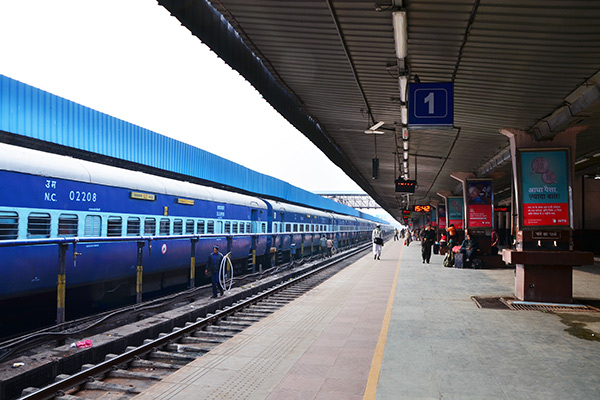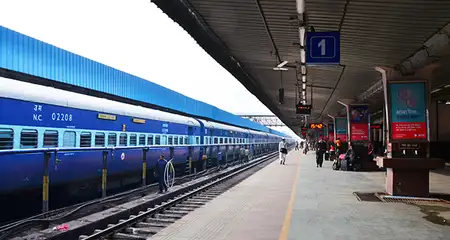Indian Railways is one of the most popular and busiest modes of transportation in India and connects numerous cities, towns, states, districts, and regions. In order to achieve this humongous feat, Indian Railways operates various types of trains that include high-speed, fully air-conditioned premium trains, point-to-point superfast trains, mountain railways (declared as UNESCO World Heritage Site), metro trains for fast urban transport, and even slow, cost-effective passenger trains, to name just a few.
Want to know more? Here’s a comprehensive list of the different types of trains operated by Indian Railways.
1. Rajdhani Express
Rajdhani Express trains connect the national capital, New Delhi to various state capitals or the largest cities of several states. These are fully air-conditioned, high-speed, long-distance trains with limited stops and run at a maximum speed of 130-140 km/hr. As of now, 24 pairs of Rajdhani trains are operated by Indian Railways. Learn more about Rajdhani trains here.
2. Duronto Express
Duronto Express trains are a premium category, long-distance, superfast trains that connect several state capitals and metro cities of India. While some Duronto trains are fully air-conditioned, some run with non-air-conditioned sleeper-class as well. These trains have a speed limit of 130 km/hour and operate with fewer stops. As of today, 26 pairs of Duronto trains are running on India’s tracks. Learn more about Duronto Express trains here.
3. Shatabdi Express
Shatabdi Express trains are super-fast and fully air-conditioned trains that connect major Indian cities. These are day-trains that operate between short to medium distances and make round trips on the same day itself. They have only seats (Chair Car) instead of berths. The Swarna Shatabdi Express is a luxurious variant of the Shatabdi Express trains. Currently, there are 25 pairs of trains in this series. Learn more about Shatabdi Express trains here.
4. Jan Shatabdi Express
Jan Shatabdi Express trains are an economical version of the Shatabdi Express. These superfast day-trains offer the option of both air-conditioned and non-air-conditioned travel classes (AC Chair Car and Second Seating). They operate at a top speed of 140 km/hr.
5. Sampark Kranti Express
Sampark Kranti Expresses are superfast express trains that link the national capital, New Delhi with the state capitals or one of the important cities of a state. They are an inexpensive alternative to Rajdhani Express trains and offer high-speed travel at low cost in both AC and Non-AC coaches. These trains operate at a maximum speed of 110 km/hr. Learn more about Sampark Kranti trains here.
6. Garib Rath Express
Garib Rath Express trains are economical, fully air-conditioned trains that provide high-speed connectivity at subsidized rates. These three-tiered, no-frills, long-distance trains operate at a maximum speed of 140 km/hr.
7. Humsafar Express
Humsafar Express trains are long-distance, fully air-conditioned, three-tier trains. They are equipped with several facilities like LED screens providing information about train speed and stations, CCTV cameras, a PA system, coffee/tea vending machines, charging ports, smoke alarms, refrigeration and heating facilities, and bio-toilets.
8. Kavi Guru Express
Kavi Guru Express trains are a series of four pairs of trains launched in honor of Nobel laureate Rabindranath Tagore, who is referred to as Kavi Guru in Bengali. Out of these four pairs, one is a superfast express train.
9. Vande Bharat Express
Vande Bharat Express is a recently launched, fully air-conditioned, semi-high-speed, intercity day-train. Also known as Train 18, this train offers various facilities, such as CCTV cameras, Wi-Fi, hydraulic-pressure doors, snack tables, and smoke/fire detection and extinguishing system. It runs at a speed of 200 km/hr, making it one of the fastest trains in India.
10. Tejas Express
Tejas Express trains are semi-high-speed, air-conditioned, chair car trains boasting of several onboard amenities, like LED TV with charging socket, CCTV cameras, Wi-Fi, snack tables, coffee/tea vending machines, celebrity chef menu, smoke/fire detection and extinguishing system, sensor water taps, and bio-vacuum toilets, to mention a few. These trains have the capacity to clock 200 km/hr, but due to technical reasons, their speed is restricted to 130 km/hr.
11. Gatiman Express
Gatimaan Express is the country’s first semi-high speed train that connects Jhansi to New Delhi. It is an air-conditioned chair car train equipped with various modern facilities like Wi-Fi, GPS-based passenger information system, fire alarms, sliding doors, and bio-toilets. It also has train hostesses to serve the passengers on-board. This train runs at a top speed of 160 km/hr.
12. Vivek Express
Vivek Express is a series of four pairs of express trains introduced to mark the 150th birth anniversary of Swami Vivekananda. At present, the Dibrugarh – Kanyakumari Vivek Express covers the longest rail route in the country.
13. Rajya Rani Express
Rajya Rani Express trains link the state capitals with several major cities that are considered significant for tourism, pilgrimage, or business purposes.
14. Jan Sadharan Express
Jan Sadharan Express trains are fully non-reserved passenger express trains that offer affordable transport options to the common people. They operate on various peak routes at a speed of 50 km/hr.
15. UDAY Express
Utkrisht Double Decker Air-Conditioned Yatri Express or UDAY Express are air-conditioned, double-decker, chair car trains meant to offer luxury transportation to business travelers. These trains offer several facilities, such as airline-style seating arrangements, Wi-Fi, food vending machines, information screens, onboard café, etc. They operate at a maximum speed of 110 km/hr.
16. Antyodaya Express
Antyodaya Express trains are fully unreserved, high-speed trains that operate on peak routes of India’s railway network. These overnight trains are designed to provide fast connectivity at highly affordable rates.
17. Mahamana Express
Mahamana Express is a series of superfast express trains that have Model Rake coaches. The train is named in honor of educationist and freedom fighter Pandit Madan Mohan Malaviya.
18. Suvidha Express
Suvidha Express aka Premium Express is a series of trains that operate on the busiest rail routes of the country. These trains follow dynamic pricing. They have no options for Taktal reservations, concessions (for differently-abled passengers, senior citizens, etc.), Ladies Quota, or even cancellation.
19. Yuva Express
Yuva Express trains were introduced to provide affordable, air-conditioned travel option to the youths of India. These trains have sixty percent of their seats reserved for travelers between the age range of 18 to 45 years, students, and economically weak people.
20. Double Decker Express
Double Decker Express trains comprise of rail carriages that have bi-level seating facility for passengers. These are fast-speed, air-conditioned, day-travel express trains with limited stops.
21. AC Express
AC Express trains are completely air-conditioned trains that connect several major cities of the country. These passenger trains operate with high speed, limited stops, and offer lower travel rates in comparison to the premium trains. They can run at a maximum speed of 130 km/hr.
22. Intercity Express
Intercity Express trains serve to link the state capitals with prime railway junctions. These trains run on short routes with high or semi-high speed. They are more affordable than other express trains and usually have only seats and no berths.
23. Express
Express trains run with a maximum speed of more than 100 km/hr, which places them above local or ordinary passenger trains. They also have limited stops, which help them maintain a relatively higher speed.
24. Superfast Express
Superfast Express trains operate with fewer stops in comparison to ordinary express trains and have shorter travel times. They run with a maximum speed of 100-110 km/hr. Fares of these trains include a superfast surcharge, which makes them more expensive than ordinary express trains.
25. Passenger
Passenger trains provide economical travel options at slow speeds of about 40-80 km/hr. They often have non-reserved seating arrangements. These trains stop at almost every station on their route. They are classified as slow passenger trains and fast passenger trains.
26. Mail
Mail Trains once had exclusive coaches to carry mails and that’s how they got the name. At present, all trains in India use their luggage coach to carry mails. Even mail trains follow the same policy, but the name remains in use.
27. Suburban
Suburban trains aka local trains operate between a centrally located business district and the suburban areas. These trains generally have non-reserved seating arrangements and stop at every station on a route.
28. Mountain Railways
Mountain Railways are train lines that pass through the mountains of India. Out of the seven mountain railways of the country, three have been declared as World Heritage Sites by UNESCO and named as Mountain Railways of India. These are the Darjeeling Himalayan Railway aka Toy Train, the Kalka–Shimla Railway, and the Nilgiri Mountain Railway.
29. Luxury Trains
Luxury trains are tourist trains that operate across various regions of the country. As part of this service, Indian Railways runs luxury tourist trains, Buddhist circuit special trains, semi-luxury trains, Aastha Circuit trains, Bharat Darshan trains, and steam trains. Palace on Wheels, Royal Rajasthan on Wheels, Maharajas’ Express, Deccan Odyssey, Golden Chariot, and Mahaparinirvan Express are some of the luxury trains operated by the Indian Railways. The Fairy Queen is a luxury train that runs from Delhi to Alwar. It is hauled by the oldest steam engine in the world, which makes it a tourist attraction in itself.












